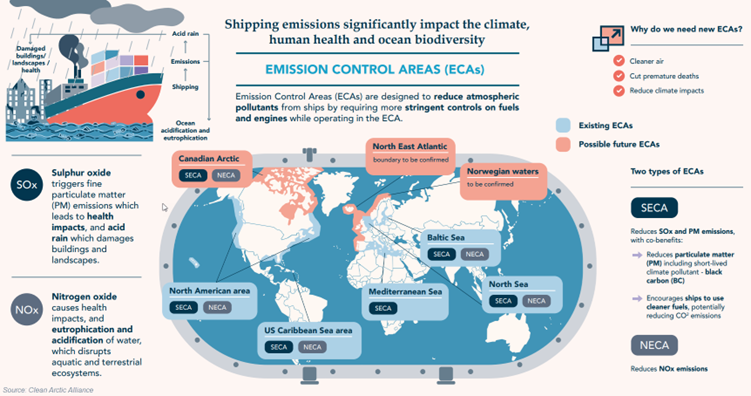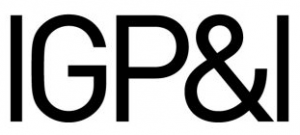The previously announced Mediterranean Sea ECA is set to take effect on 1 May 2025. In addition, Norway and Canada have submitted proposals to designate the Norwegian Sea and parts of the Canadian Arctic as ECAs and work is also underway on a new ECA in the North-Atlantic Ocean.

Watch out for new emission control areas
Published 24 January 2024
As the maritime industry continues its efforts to achieve net zero emissions by 2050, steps are also being taken to reduce the negative effects that ship emissions of sulphur oxides (SOx) and nitrogen oxides (NOx) have on human health and the environment today. In December 2022, the IMO adopted amendments to MARPOL Annex VI and established a Mediterranean Sea emission control area (ECA) that will take effect on 1 May 2025. This is the fifth ECA designated under MARPOL Annex VI, following the Baltic Sea, North Sea, North American, and US Caribbean Sea ECAs. An overview of all MARPOL designated ECAs is available in the latest version of IMO document MEPC.1/Circ.778.
Three new ECAs on the IMO agenda
Ahead of the MEPC 81 meeting in April 2024, Norway and Canada have proposed new ECAs in the Norwegian Sea and parts of the Canadian Arctic respectively. In addition, a proposal for a North-East Atlantic Ocean ECA may be ready for MEPC 81. Should this be the case, and all goes as planned, three new ECAs could be adopted by spring 2025 and take effect in 2027.
The three prospective ECAs would prohibit ships from using fuel with a sulphur content greater than 0.10% m/m, or achieve equivalent emission reductions using approved technology, and would require all ships constructed after a certain date to comply with NOx Tier III limits as specified in Reg.13 of MARPOL Annex VI.
The proposed Canadian Arctic ECA includes Arctic waters under Canadian sovereignty, from the 137th meridian west in the Beaufort Sea to the existing North American ECA boundary in the east. Canada’s proposal is detailed in IMO document MEPC 81/11.
The proposed Norwegian Sea ECA covers the Norwegian Exclusive Economic Zone north of 62 degrees latitude and includes Norwegian fjords and coastal waters. Norway’s proposal is detailed in IMO document MEPC 81/11/1.
At the time of writing, the North-East Atlantic Ocean ECA has not been described in detail. However, according to a paper submitted to MEPC 80 (MEPC 80/INF.35), it would link the existing ECAs in the Baltic Sea, North Sea and English Channel with the upcoming Mediterranean Sea ECA. And if taking into account the designation of the additional Norwegian Sea ECA, this essentially means that most European waters will be covered by ECAs.
An infographic provided by the Clean Arctic Alliance provides a useful overview of existing and possible future ECAs designated under MARPOL Annex VI.

CleanArticAlliance_ECA_Jan2024
Are ECAs effective?
Along with controls on emissions that apply to ships globally, such as the introduction of a 0.50% global sulphur cap in 2020, the establishment of regional ECAs is considered an effective tool to improve air quality in coastal communities.
The North American ECA began to apply in 2012 for the 1.00% sulphur limit and in 2015 for the 0.10% sulphur limit. The Tier III NOx limits, which apply only to engines installed on new ships while operated in the ECA, began to apply to ships built in 2016. This means that the Tier III NOx limits and the most stringent sulphur limit have been in effect in the North American ECA for eight and nine years respectively. However, have the stringent requirements brough about the desired air quality improvements?
In a paper submitted to the IMO in November 2023 (PPR 11/INF.4), the US Environmental Protection Agency (EPA) concludes that the fuel sulphur controls applied in the North American ECA have resulted in considerable reductions of particulate matter emissions from international shipping, whilst the expected reductions in NOx emissions have not been achieved. Due to a slow fleet turnover to Tier III ships, very few ships equipped with Tier III engines are operating in the US sections of the North American ECA, and, even for those few ships, the Tier III emission control technology may not be engaged for much of the operation time in order to protect engines during slow steaming.
Similar trends are described by the UK Department of Transport in its “Open call for evidence: Extending the emission control area to all UK waters“ published on 9 January 2024.
Recommendations
Ship operators should take note of the above and make sure their bunkering procurement and onboard operating procedures comply with MARPOL requirements in force at any given time. To be compliant it is important to ensure that enough fuel with the appropriate sulphur content is available and that proper fuel changeover procedures are in place and implemented before entering an ECA.
It is also important to keep in mind that regions, states and ports around the world may have implemented their own strict sulphur emission limits. A round-up of some of these paces is included in our insight “Regional sulphur emission limits at a glance”. Ship operators must therefore ensure that crews are familiar with the sulphur emission limits in force, not only in the MARPOL designated ECAs, but in all jurisdictions to which they trade. Crews should also be provided with clear procedures and guidance to this effect. As new local regulations or changes to existing legislation can be implemented with very little notice, and the regulatory enforcement strategy may differ from one region/port to another, ships’ masters should always seek advice from their agents on local requirements well in advance of the ship’s intended port call.
And by the way…
Although not primarily aimed at reducing ship emissions, another MARPOL regulation that dictates fuel properties is due to take effect on 1 July 2024, namely the prohibition on the use and carriage of heavy fuel oil (HFO) in Arctic waters under MARPOL Annex I. The amended MARPOL Annex I is detailed in IMO Resolution MEPC.329(76).
All referenced IMO documents can be downloaded via IMODOCS Public Accounts (free registration).


